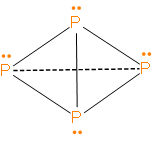Answer
340.6k+ views
Hint: The easiest way to solve this question is by calculating the hybridization of the compound given above. We generally consider the hybridization of the central element, but in this case, all the atoms will act the same, i.e. hybridization of all four phosphorus will be the same.
Complete answer:
The molecule is also known as tetraphosphorus.
Let us check the structure and geometry of white phosphorus by calculating its hybridization. Hybridization of white phosphorus can be added to the number of sigma bonds and number of lone pairs of the atom. We can represent hybridization by the term ‘Z’.
But first let us draw the structure of white phosphorus.

From the structure, we can clearly see that each phosphorus has 1 lone pair and 3 sigma bonds.
Therefore,
Z = Number of \[\text{ }\!\!\sigma\!\!\text{ }\]bonds + lone pair of phosphorus
Z = 3 + 1
Z = 4
The hybridization of white phosphorus - \[{{P}_{4}}\] - is equal to 4, which means that it is \[s{{p}^{3}}\] hybridized. Therefore, we can say that it is a tetrahedron.
Also, we can see from the structure that the four phosphorus atoms in white phosphorus \[({{P}_{4}})\] are arranged at the corners of a regular tetrahedron.
Therefore, the answer is – option (c) – Atoms in \[{{P}_{4}}\] molecules of white phosphorus are arranged regularly at the corners of a tetrahedron.
So, the correct answer is “Option C”.
Additional Information:
Hybridization is based on the concept that atomic orbitals of nearly same energy intermix to give new orbitals of the same energy.
Note:
The hybridization of a compound can be related to its geometry by the following table –
Complete answer:
The molecule is also known as tetraphosphorus.
Let us check the structure and geometry of white phosphorus by calculating its hybridization. Hybridization of white phosphorus can be added to the number of sigma bonds and number of lone pairs of the atom. We can represent hybridization by the term ‘Z’.
But first let us draw the structure of white phosphorus.

From the structure, we can clearly see that each phosphorus has 1 lone pair and 3 sigma bonds.
Therefore,
Z = Number of \[\text{ }\!\!\sigma\!\!\text{ }\]bonds + lone pair of phosphorus
Z = 3 + 1
Z = 4
The hybridization of white phosphorus - \[{{P}_{4}}\] - is equal to 4, which means that it is \[s{{p}^{3}}\] hybridized. Therefore, we can say that it is a tetrahedron.
Also, we can see from the structure that the four phosphorus atoms in white phosphorus \[({{P}_{4}})\] are arranged at the corners of a regular tetrahedron.
Therefore, the answer is – option (c) – Atoms in \[{{P}_{4}}\] molecules of white phosphorus are arranged regularly at the corners of a tetrahedron.
So, the correct answer is “Option C”.
Additional Information:
Hybridization is based on the concept that atomic orbitals of nearly same energy intermix to give new orbitals of the same energy.
Note:
The hybridization of a compound can be related to its geometry by the following table –
| Z | Hybridization | Geometry |
| 2 | \[sp\] | Linear |
| 3 | \[s{{p}^{2}}\] | Trigonal planar |
| 4 | \[s{{p}^{3}}\] | Tetrahedral |
| 5 | \[s{{p}^{3}}d\] | Trigonal bipyramidal |
| 6 | \[s{{p}^{3}}{{d}^{2}}\] | Octahedral |
| 7 | \[s{{p}^{3}}{{d}^{3}}\] | Pentagonal bipyramidal |
Recently Updated Pages
Basicity of sulphurous acid and sulphuric acid are

Three beakers labelled as A B and C each containing 25 mL of water were taken A small amount of NaOH anhydrous CuSO4 and NaCl were added to the beakers A B and C respectively It was observed that there was an increase in the temperature of the solutions contained in beakers A and B whereas in case of beaker C the temperature of the solution falls Which one of the following statements isarecorrect i In beakers A and B exothermic process has occurred ii In beakers A and B endothermic process has occurred iii In beaker C exothermic process has occurred iv In beaker C endothermic process has occurred

What is the stopping potential when the metal with class 12 physics JEE_Main

The momentum of a photon is 2 times 10 16gm cmsec Its class 12 physics JEE_Main

How do you arrange NH4 + BF3 H2O C2H2 in increasing class 11 chemistry CBSE

Is H mCT and q mCT the same thing If so which is more class 11 chemistry CBSE



